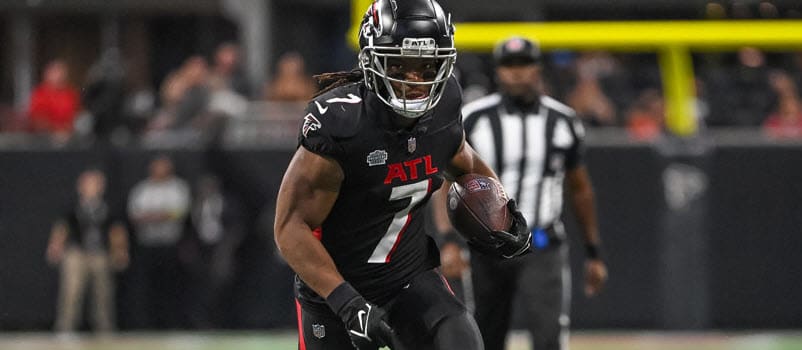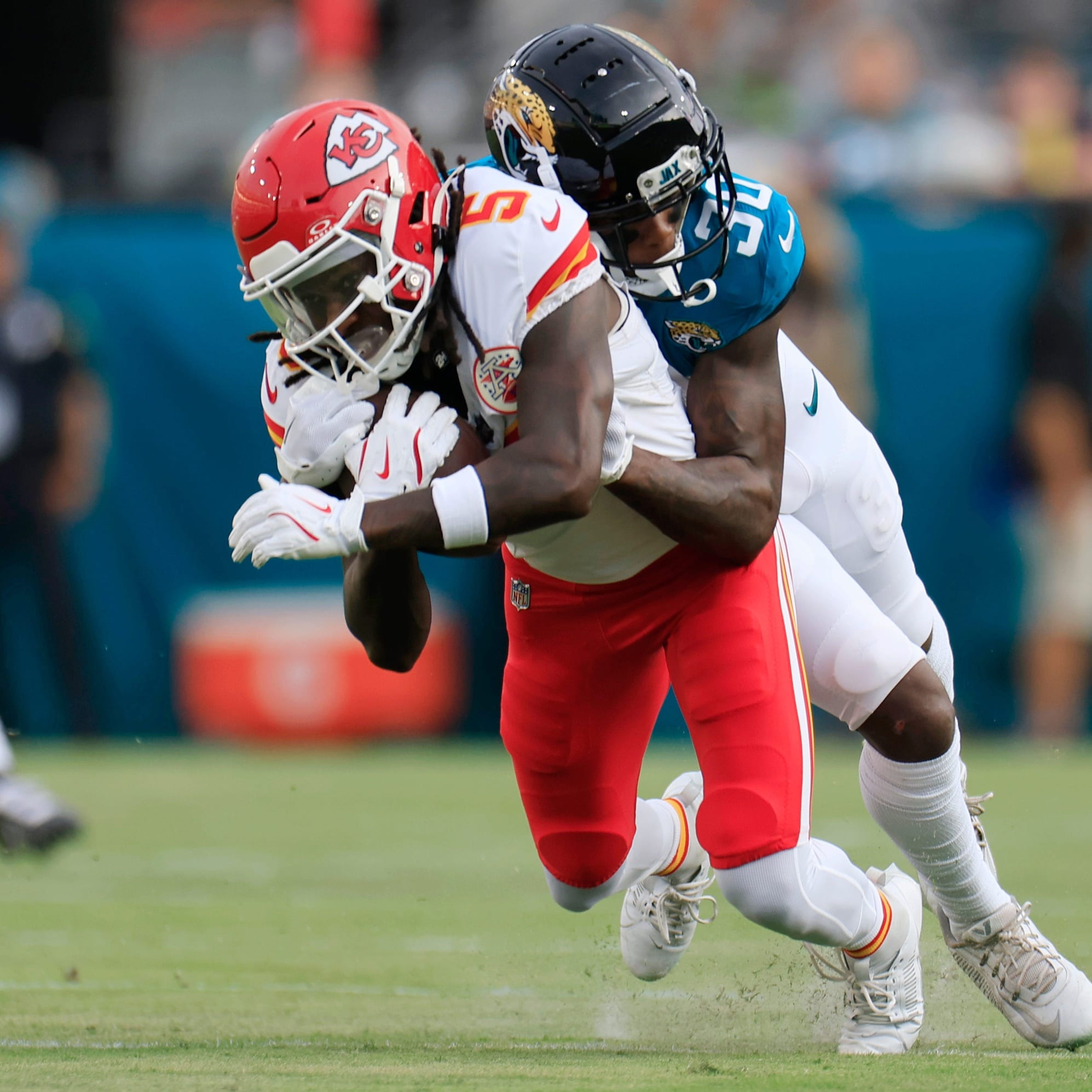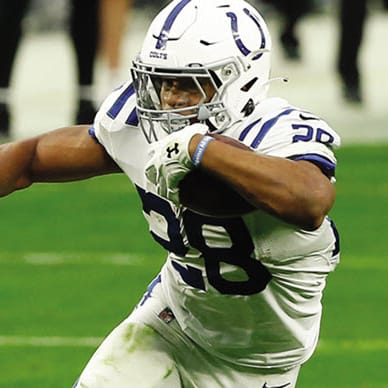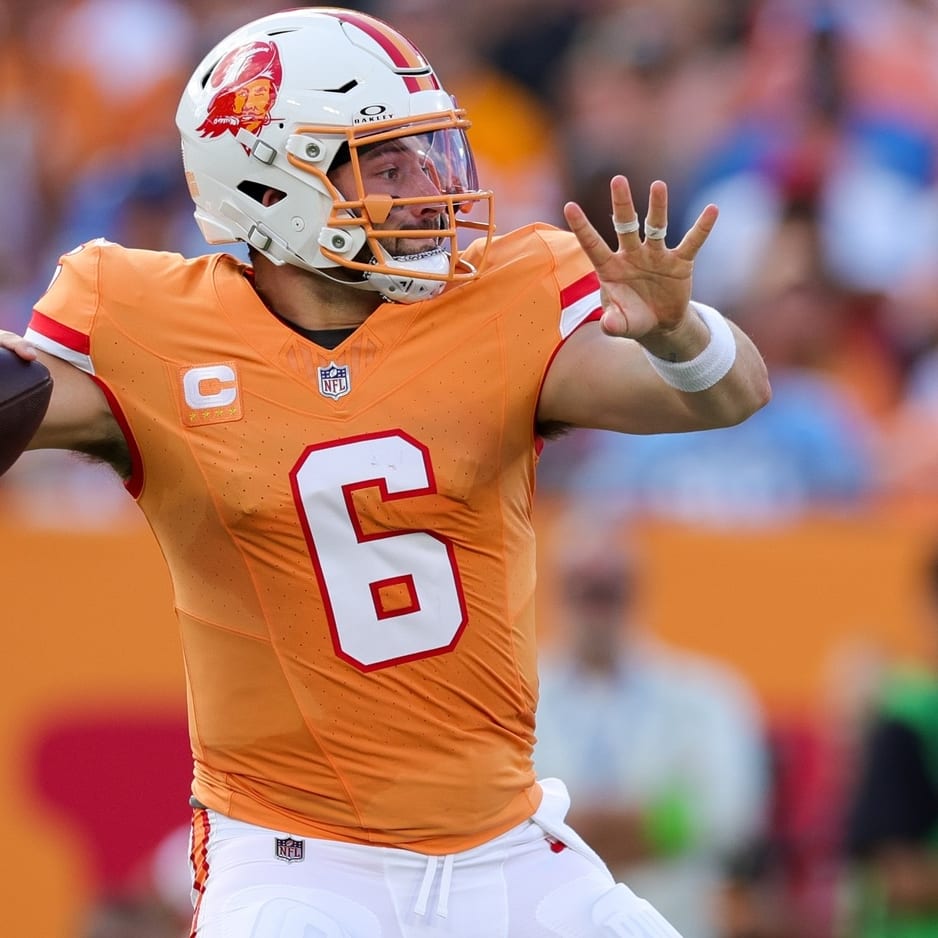This article is part of our Fantasy Football Draft Strategy series.
I'm a fraud for it but since I can't write it any better myself I'm going to quote the preface written by Jerry Donabedian in his article about drafting from slots 1-through-3.
It helps a lot if you know ahead of time what type of competition you're facing and what to expect in terms of prioritization of positions. My "home" league tends to have drafts that look pretty similar to ADP data from expert, high-stakes and best-ball leagues, but that's probably not the case for a lot of people.
The general trend is that leagues with less-experienced or lower-volume drafters tend to see QBs and RBs drafted earlier and WRs drafted later, e.g., Saquon Barkley might be a first-round pick and Josh Allen a second-rounder, which is basically never happening these days in best-ball lobbies or high-stakes leagues. If you're not sure where your league falls, one decent proxy to help with expectations is knowing how many other leagues most of your competitors are participating in.
If most are playing in only one or two leagues, there's a good chance starting RBs will tend to go fairly early and people will want to fill out starting lineups before selecting backups. If most of your opponents are playing in a lot of leagues, there's a better chance you'll see "zero RB" teams or other strategies that entail seemingly imbalanced rosters through the first 6-8 rounds.
With all of that in mind, this article will look at the ways you might approach
I'm a fraud for it but since I can't write it any better myself I'm going to quote the preface written by Jerry Donabedian in his article about drafting from slots 1-through-3.
It helps a lot if you know ahead of time what type of competition you're facing and what to expect in terms of prioritization of positions. My "home" league tends to have drafts that look pretty similar to ADP data from expert, high-stakes and best-ball leagues, but that's probably not the case for a lot of people.
The general trend is that leagues with less-experienced or lower-volume drafters tend to see QBs and RBs drafted earlier and WRs drafted later, e.g., Saquon Barkley might be a first-round pick and Josh Allen a second-rounder, which is basically never happening these days in best-ball lobbies or high-stakes leagues. If you're not sure where your league falls, one decent proxy to help with expectations is knowing how many other leagues most of your competitors are participating in.
If most are playing in only one or two leagues, there's a good chance starting RBs will tend to go fairly early and people will want to fill out starting lineups before selecting backups. If most of your opponents are playing in a lot of leagues, there's a better chance you'll see "zero RB" teams or other strategies that entail seemingly imbalanced rosters through the first 6-8 rounds.
With all of that in mind, this article will look at the ways you might approach a draft while working from slots 7-through-9.
Round 1
Other than the first overall slot (Christian McCaffrey, usually), this range of the first round is probably the stretch best suited to picking a running back in the first round. The candidates are Bijan Robinson and Breece Hall, though either or both are sometimes gone by the seventh selection – on NFFC Robinson (5.09) and Hall (4.28) especially. This isn't to say that someone picking from 7-through-9 needs to plan on taking a running back here if available, but the case for either of Robinson or Hall is that they are the unique category of running back capable of finishing as the RB1, owed to the fact that they are both high-volume, high-efficiency running backs capable of catching 60 or more passes. There are very few running backs who project for potentially 250-plus carries and 60-plus receptions.
The wide receiver options at 7-through-9 are plenty worth their own hype, however, as Justin Jefferson, Amon-Ra St. Brown, A.J. Brown and Puka Nacua have all proven themselves fantasy WR1s, and wide receivers go earlier than ever these days.
In any case, if you take Robinson or Hall then with your second selection you'll probably want to plan on taking a wide receiver. If you go wide receiver with your first selection, however, you can go in pretty much whatever direction you'd like in the second round (within ADP reason, anyway).
Round 2
This selection would be in the range of picks 16-through-18.
If you took Robinson or Hall you're not compelled to go wide receiver with this pick, but going RB-RB with your first two picks should be understood as a risky strategy, and one that puts a lot of pressure on yourself to find viable wide receiver production in the points of the draft where you're least likely to find it. Players like Jahmyr Gibbs, Jonathan Taylor, and Saquon Barkley would all otherwise be strong running back picks here, but they also tend to be gone on NFFC. Gibbs especially appears unlikely to make it to the 16th pick.
The wide receiver options in this range tend to be Nico Collins, Chris Olave, Deebo Samuel, Jaylen Waddle, Davante Adams and Brandon Aiyuk. There's no objective ranking to order them, but in general their ADP will go in that order.
You might notice that, great as Collins et al might be, this group is a fairly clear dropoff from the Round 1 wideouts. A similar dropoff will occur from the second round to the third, so that's why I don't recommend starting the draft RB-RB, tempting as the names might be in both rounds.
Round 3
As long as your draft doesn't feature a third-round reversal, these picks will be 31-through-33. Let's just assume you went RB-WR, WR-WR or WR-RB with your first two selections.
This section of the draft order is interesting if only because it's where the tight ends first come off the board – Sam LaPorta and Travis Kelce, specifically. Without advocating any particular stance on the strategy, those who want LaPorta or Kelce shares should probably plan on selecting them with this pick.
If LaPorta or/and Kelce don't interest you here then you might want to plan on going wide receiver here. Running backs like Travis Etienne, Kyren Williams, De'Von Achane are often gone by now, especially on NFFC, and picks 31-through-33 would be a bit early to take any of the next wave of running backs (Rachaad White, Josh Jacobs, etc.). ADP-wise the more sound values would arguably be wideouts like DJ Moore, Michael Pittman, Stefon Diggs, and Zay Flowers.
If you're in the hunt for a top quarterback like Josh Allen, Jalen Hurts or Patrick Mahomes then you'll want to check the ADP of quarterbacks on the site in question. In some formats Allen especially will go as early as the early third round, even before the 31st selection, so needless to say you shouldn't plan on Allen/Hurts/Mahomes making it to the fourth round in such formats.
Rounds 4-5
As mentioned previously the likes of Allen, Hurts and Mahomes are not guaranteed to make it to this selection (43-through-45 and 52-to-54), but if they do then it becomes a lot easier to settle on the pick. There aren't many quarterbacks who pose weekly 30-point potential, so you can understand why Allen/Hurts/Mahomes often or usually don't make it this far.
Your running back options might be some combination of Josh Jacobs, Rachaad White, James Cook and Joe Mixon. If you haven't taken a running back yet this might be a good time to do it, otherwise all four of these players are expected to be strong RB2 types.
The most interesting wideouts in this range include George Pickens, Amari Cooper, Christian Kirk, Terry McLaurin, Tee Higgins, Tank Dell, etc. If you can get any of them as your WR3 then you're looking strong in that category.
Tight end hasn't been a major consideration since LaPorta and Kelce in Round 3, but Trey McBride, Mark Andrews and Dalton Kincaid all stand out in this range. Selecting any of them would give you a strong TE1 projection.
Rounds 6-7
With picks 64-through-66 the wide receivers begin to thin out quickly. You'll either want your top-three accounted for going into this range or hope you can snag someone like Jayden Reed or Marquise Brown here. It might be risky to go into the sixth round with fewer than three wide receivers, in other words.
If you have wide receiver accounted for but not tight end then this would be a great spot to take Kyle Pitts. Most projections agree that there's a slight cliff in the TE rankings from Pitts to the next tier, even if most also rank Pitts safely behind the McBride/Andrews/Kincaid tier.
If you don't have a quarterback yet you might find players like Anthony Richardson and C.J. Stroud interesting in this range.
Teams looking for running backs should find viable options both in the sixth (Rhamondre Stevenson, Zamir White, James Conner) and seventh (D'Andre Swift, Najee Harris), though you'll want to double-check the ADP on your drafting site to see which of the rounds they trend toward.
Rounds 8-9
By picks 88-through-90 you hopefully have your top three wideouts accounted for as well as at least one viable starting running back. There are more worthwhile wide receivers in this range as well – think Jaxon Smith-Njigba, Jordan Addison, Rome Odunze, Xavier Worthy – but ideally none of them would be any higher than WR4 on your depth chart.
If you missed out on tight ends up to this point then you probably want to resolve the matter now. It's not fun to be one of the last teams to draft a tight end, especially once guys like Evan Engram and George Kittle are off the board. Jake Ferguson is unlikely to make it far into the ninth round, either.
If you are still waiting on your RB2 then you might want to consider runners like Jonathon Brooks, Jaylen Warren, Tony Pollard, etc. Such players would make for fine RB3/flex investments as well, but if you go past the eighth round with only one running back then you'll want to plan on spamming the position in the later rounds, setting aside more of your bench for lottery ticket running backs to make up for the lack of established depth in the meantime.
The quarterback options in this range often look like a good value – Kyler Murray, Joe Burrow and Dak Prescott all are capable of finishing the year as top-five fantasy quarterbacks – so if you've waited this long on quarterback but get one of those three then it should prove a hand well-played.
Rounds 10-11
With your starting positions hopefully accounted for, this phase of the draft is more where you build depth or/and chase upside lottery tickets to place on the bench at running back and wide receiver. Unless you went cheap at quarterback and plan to stream weekly, you can probably plan on skipping any QB2 considerations for a couple rounds at least.
With picks 112-through-114 there is liable to be a wide range of players available, depending on how the draft has unfolded to this point. As the ADP becomes more subjective it becomes more reasonable to 'reach' for Your Guys, whoever they might be.
If you haven't already you might want to start rounding out your RB3/RB4 range of the depth chart, because around or by this time you'll likely see names like Trey Benson, Devin Singletary, Brian Robinson, Chase Brown, Javonte Williams, etc. go off the board.
The wide receivers in this range aren't compelling exactly, but there are cases to be made for guys like Josh Palmer, Curtis Samuel, Tyler Lockett, Romeo Doubs, Khalil Shakir, and Rashid Shaheed. All of them are capable of pushing for WR3 utility, but you can get them here as a WR4 or WR5 without the cost hurting too much.
The tight end options in this range would ideally be your TE2 rather than the TE1, but Brock Bowers and David Njoku are probably your best-case options. The more realistic options would probably be Dallas Goedert, Pat Freiermuth, etc.
Rounds 12-13
Rather than Rounds 10 and 11, this is probably the range where you'd start to consider backups at quarterback and tight end.
Near picks 136-through-138 you'll often see Jared Goff, Tua Tagovailoa, Trevor Lawrence, Justin Herbert, etc. start to go off the board, give or take a round. Any of them should prove a strong QB2 or weak QB1.
The tight end options in this range are unfortunately not inspiring. Someone like Dalton Schultz is probably about the best you can do, although he would likely be strong by TE2 standards.
Rather than lukewarm options at quarterback or tight end, this range might be better spent buying lottery tickets at running back. Guys like Jaylen Wright, Kendre Miller, Ty Chandler, Tyler Allgeier, Chuba Hubbard, Ray Davis, etc. have the potential to emerge as RB2 types this year, but hopefully you have the luxury of stashing them more like an RB4 or RB5.
There are also some worthwhile wideout considerations in this range – guys like Josh Downs, Jerry Jeudy, Mike Williams, Demario Douglas, Gabe Davis and the like – but they should probably be understood as emergency depth rather than high-upside options. If you're looking for upside specifically at this point you're more likely to find it at running back, albeit with lower floors as the tradeoff.
Rounds 14 Onward
By this point you would ideally have a well-stocked assortment of starting personnel as well as some amount of depth and/or upside swings on your bench at running back and receiver. Most fantasy formats eventually require you to draft defense and kicker, and you'll want to give those positions their due recognition, but it's easier to stream those positions than it is to find worthwhile RB/WR/TE help during the season.
It's probably a little easier yet to stream defense than kicker. High-quality kickers in high-quality offenses score more than their contraries, and most of the players beyond that category are little more than a randomized variable from week to week. For what it's worth, in my NFFC draft I took Brandon Aubrey (Dallas Team Kicker, more precisely) in the early 17th round, and I waited on defense until taking the Chargers in the 19th (the 14th defense selected by that point in the draft). The first kicker taken was Justin Tucker, taken the pick before I took Aubrey, and the first defense (Baltimore) was taken with the third pick in the 14th round.









